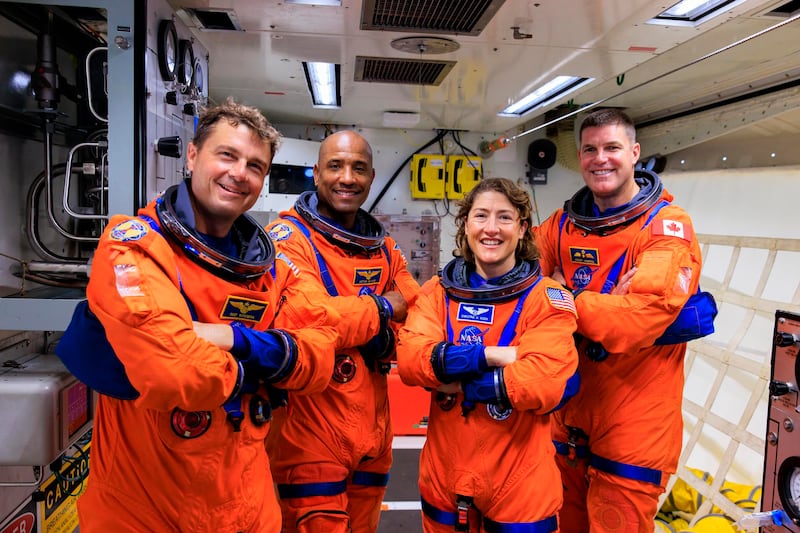- NASA announced a launch date for first crewed flight to the moon since 1972.
- The Artemis II mission will circle the moon but not land on the surface.
- If successful, NASA is set to put humans on the lunar surface in 2027.
The last time a human has traveled beyond low Earth orbit came aboard the final Apollo mission over 50 years ago.
And it’s been eight years since NASA debuted Artemis, the U.S. space agency’s program aiming to lift astronauts not only beyond the confines of LEO but back to the surface of the moon.
This week, NASA announced plans to take the next critical step toward that goal with a crewed space flight that could launch early next year, aiming to travel the 250,000 miles to Earth’s sole satellite, and a bit beyond, in a precursor lunar fly-by mission ahead of a hoped-for moon landing in 2027.
“The agency has made a commitment to launch no later than April of 2026 and we intend to keep that commitment,” Lakiesha Hawkins, NASA’s acting deputy associate administrator, said at a Tuesday press conference. “We’re also, though, working to accelerate, as much as we can, in terms of the preparations and the operations, to potentially as early as February.”
Four astronauts, commander Reid Wiseman, pilot Victor Glover and mission specialists Christina Koch and Jeremy Hansen, are slated to fly the 10-day Artemis II mission, launching from Kennedy Space Center aboard the Orion capsule powered by the massive SLS rocket system. The crew’s flight will take them on a path arcing about 5,000 miles past the moon before returning to Earth for a planned splashdown landing in the Pacific Ocean off the coast of San Diego.
Next year’s planned journey follows 2022’s Artemis I mission, a $4.1 billion effort which saw a successful 25-day unmanned flight that tested out the SLS rocket/Orion capsule package. That mission took the Orion spacecraft, carrying three dummies outfitted in spacesuits and monitoring gear, within 81 miles of the lunar surface before eventually traveling some 40,000 miles past the moon before returning to Earth.
If the Artemis II mission goes to plan, NASA intends to launch the SLS/Orion package on a mission in 2027 that will include a landing on the moon’s surface.
A space race redux?
Hawkins said, however, that NASA’s bigger goal extends far beyond just revisiting the success of the Apollo program in putting astronauts on the lunar surface amid a global space race that’s reminiscent of the rush toward space exploration in the 1960s.
“Yes, we are returning to the moon and yes we are moving in accelerated fashion to get to the surface of the moon. But what’s different is we are going back to the moon to establish a sustained presence on the moon ... and demonstrating long-term capabilities on the surface of the moon,” she said.
“We are demonstrating those capabilities so that we can go on to the next decision. We’ve got our eyes set further, deeper into space onto Mars and being able to show we can establish a presence on Mars and further destinations.”
Hawkins also noted President Donald Trump’s administration is backing the freshly accelerated Artemis program schedule.
“The message has been clear to us that this administration asks us to acknowledge that we are indeed in ... what people have commonly called a second space race,” Hawkins said. “There is a desire for us to return to the surface of the moon and for us to be the first to return to the surface of the moon.”
Why should we return to the moon?
In a posting on the Artemis missions’ website, NASA lists a few reasons why it’s once again devoting billions of dollars to making moon landings a priority.
“We’re going back to the moon for scientific discovery, economic benefits and inspiration for a new generation of explorers: the Artemis Generation,” NASA says. “While maintaining American leadership in exploration, we will build a global alliance and explore deep space for the benefit of all.”
While a return to the moon smacks a little of “been there, done that,” NASA says it’s committed to accomplishing some other first benchmarks as part of the series of Artemis missions, including extending manned exploration deeper into the solar system.
“With Artemis missions, NASA will land the first woman and first person of color on the moon, using innovative technologies to explore more of the lunar surface than ever before,” NASA says in a web posting. “We will collaborate with commercial and international partners and establish the first long-term presence on the moon. Then, we will use what we learn on and around the moon to take the next giant leap: sending the first astronauts to Mars.”
SLS fun facts and a Utah connection
NASA says its SLS launch system stands at 322 feet high — taller than the Statue of Liberty — and weighs 5.75 million pounds when loaded with fuel.
During launch and ascent, the SLS produces 8.8 million pounds of maximum thrust, 15% more thrust than the Saturn V rockets that propelled Apollo astronauts to the moon.
Utah-based aerospace companies and experts have long played a role in NASA space missions, and the Artemis program is no exception. The massive solid fuel booster rockets that provide some 75% of the SLS initial thrust were developed and tested in Utah by Northrop Grumman in partnership with NASA.


